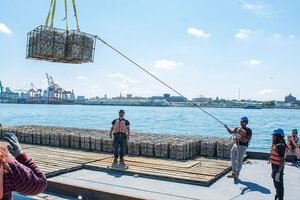Aw shucks! Can oysters clean up New York’s harbor?

Juvenile oysters grow on shells reclaimed from restaurants as part of the Billion Oyster Project in New York City. The project is reestablishing oyster reefs in the New York Harbor to help revitalize the waters.
Courtesy of the Billion Oyster Project
GOVERNORS ISLAND, N.Y.
Most New Yorkers wouldn’t dream of eating a fish from New York Harbor. But it hasn’t always been that way.
When Europeans first colonized the area, the water was clear and seafood was so abundant, legend has it, that it could be harvested by the basketful. Most abundant of all were the oysters.
Indeed, oysters were so plentiful that they were sold on street corners like hot dogs are today. But all that changed due to overharvesting, dredging, and a flood of pollution in the water. The oyster reefs disappeared, and the harbor became etched in New Yorkers’ minds as a no-go zone.
Why We Wrote This
When residents are accustomed to pollution, it can be difficult to muster support to do something about it. Most New Yorkers have a hard time imagining a clean harbor. The Billion Oyster Project aims to change that.
But today a team of high school students, scientists, and volunteers are working to change that.
“Through the work of restoring a billion oysters, we hope to reinsert the harbor into the consciousness of New Yorkers,” says Pete Malinowski, executive director of the Billion Oyster Project, which aims to reestablish oyster reefs in the harbor.
Oysters are more than just a popular appetizer. Their reefs provide habitat for a variety of aquatic species, and they break storm surges that could otherwise devastate the coastline. Oysters also help clean the water.
“You don’t lose having oysters. You always gain,” says Gulnihal Ozbay, a researcher at Delaware State University who specializes in marine habitat restoration.
Much of the pollution afflicting the harbor today comes from sewage overflows, which occur when heavy rains overwhelm the city’s combined sewage overflow system, spilling wastewater into the harbor.
Sewage contains a lot of nitrogen, an essential nutrient for plants and animals. But too much nitrogen triggers algae blooms, which suck oxygen out of the water to create so-called dead zones.
The antidote? Oysters, say Mr. Malinowski, Dr. Ozbay, and others. As efficient filter-feeders, oysters remove nitrogen and incorporate it into their shells and tissue. Near oyster reefs, the water is often clearer.
Oysters weren’t completely gone when the Billion Oyster Project began in 2014. But the ones that remained were few and far between and aren’t thought to have been in many reefs.
That’s important because oysters are broadcast spawners, which means they release eggs and sperm into the water column where they form larvae. Those baby oysters have to find something to latch onto – and they prefer shells of adult oysters.
In the Billion Oyster Project, those older shells come from restaurants in the city. Students at the Urban Assembly New York Harbor School on Governors Island breed oysters and usher them through their development before planting entire chunks of oysters grown together into the harbor.
The goal of the project is to have placed 1 billion oysters into the harbor by 2035. They still probably won’t be safe to eat, with the project focusing on long-term restoration. And, Mr. Malinowski says, a billion oysters probably won’t make a huge dent in the harbor’s pollution, largely because water whips through the region. If the harbor water was standing still, he explains, 1 billion oysters could filter it roughly every three days.
Instead, the Billion Oyster Project is using this effort to educate the next generation of New Yorkers about the harbor and to stimulate interest in restoring and protecting it.
“The major benefit, I think, is the involvement of the students in creating a cadre of people who care about the harbor and are going to want to protect it,” says John Waldman, a biologist at Queens College and author of “Heartbeats in the Muck: The History, Sea Life, and Environment of New York Harbor.”
“The spirit of the kids and the teachers is palpable,” says Dr. Waldman, who is not part of the project. ”They are just so into this. It’s marvelous to see.”
To Kaya Aras, a senior at the Harbor School, the harbor had long been a place to avoid. But after working on the project, he sees it in a different light. “Having seen firsthand what the oysters do, I’m hopeful that one day the harbor will come back to what it was during the colonial era,” he says.
The harbor is already cleaner and more vibrant than some might think, says Dr. Waldman. Just a few miles from downtown Manhattan, whales have reappeared in recent years. Sonar readings of the Hudson River last summer revealed a 14-foot-long sturgeon swimming in its depths.
“[People] just haven’t been exposed to what’s going on there,” Dr. Waldman says. “There is a real lag in terms of the perceptions of the current state of the harbor.” But, he says, with projects like this, “that tide is turning.”
This story was produced in conjunction with Earth Beats, a Sparknews collaboration highlighting environmental solutions for Earth Day.
This story has been updated to include the full name of the Urban Assembly New York Harbor School.


